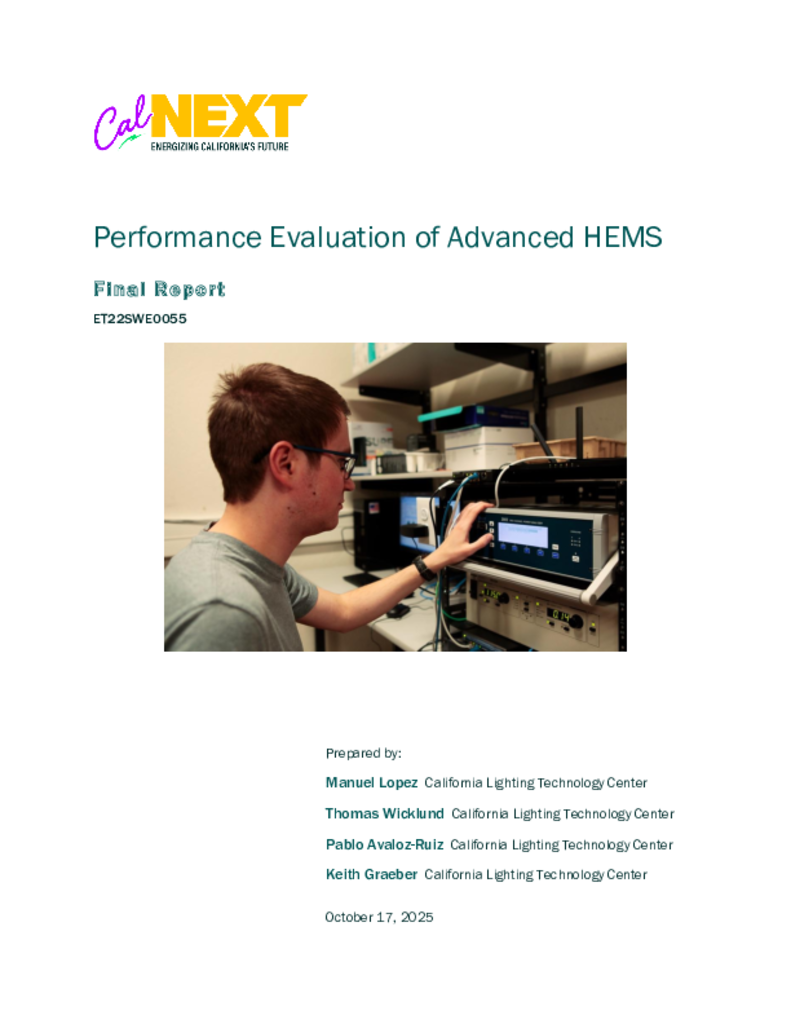ET22SWE0055 - Performance Evaluation of Advanced HEMS
The proposed project is a laboratory evaluation of advanced home energy management systems (HEMS) that will quantify the electrical efficiency associated with advanced distributed energy resource (DER) management features and assess claims of interoperability across a range of communication protocols. These systems provide one or more of the following features: home energy and demand management; grid services such as event- or price-based load shifting and demand response; interoperability with other home appliances and appliance-specific controls; integration and consolidated management of DERs such as solar photovoltaics (PV) and battery energy storage (BES); and bi-directional, electric vehicle (EV) charging; all-of-which combine to deliver improved residential energy efficiency, load flexibility, and GHG reductions. In addition, these new systems can make homes more resilient during grid outages by automatically switching loads to local battery storage when the grid is unavailable.
Advanced HEMS are currently under development by multiple companies and certain companies are marketing the technology today. Currently available technology is in prototype form and in need of independent testing to validate performance and quantify benefits. The predominant metrics will include electrical efficiency (%), annual energy saved (kw-Hr), peak load reduction (kW), GHG reductions (focused on SGIP signal), and an estimate enabled load flexibility. Outcomes will also include recommendations for improving the technology to better ensure commercial products provide significant benefits that will justify utility program support and increase market adoption across California.
The Performance Evaluation of Advanced Home Energy Management Systems project conducted a comprehensive laboratory assessment of emerging residential energy platforms to evaluate their efficiency, operational behavior, and potential contributions to grid flexibility. Four systems representing diverse architectures, from commercially deployed solar-plus-storage platforms to prototype DC-bus and vehicle-to-home configurations, were examined across key energy transmission pathways. Results demonstrated consistently high hardware efficiencies, with AHEMS 2 achieving 90–94% and AHEMS 4 reaching up to 99% efficiency in grid-related pathways. However, system value was determined not by hardware performance alone, but by control strategy. AHEMS 2 exhibited coherent, tariff-aligned dispatch behavior under Time-of-Use (TOU) operation, generating an estimated annual net benefit of $1,492 for IOU customers and avoiding approximately 4,464 kgCO₂e of emissions annually through strategic peak-period exports. In contrast, AHEMS 4, despite superior hardware efficiency, displayed erratic dispatch behavior, including off-peak discharging and missed charging opportunities, limiting real-world economic performance. Prototype systems with V2H capabilities (AHEMS 1 and AHEMS 3) were not fully testable due to hardware and software immaturity, underscoring development challenges in next-generation architectures. Overall, findings reveal a maturing market where differentiation now lies in software logic, interoperability, and grid-responsive functionality rather than raw efficiency. The study demonstrates that when AHEMS platforms pair high hardware efficiency with well-optimized control strategies, they can deliver tangible economic and environmental benefits, signaling a clear pathway for future advancements in residential energy management.

